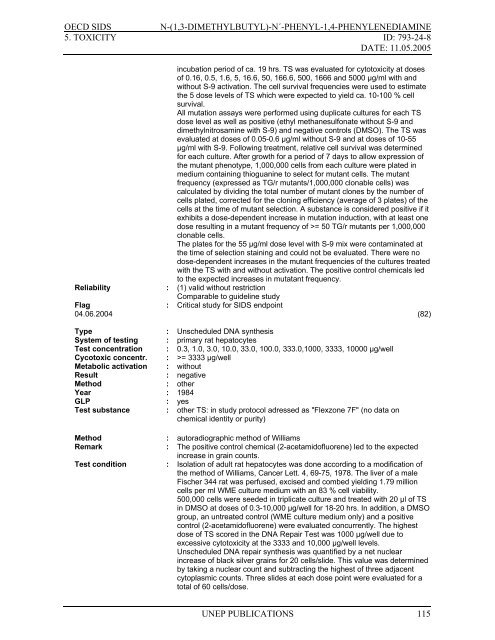N-(1,3-Dimethylbutyl)-N
N-(1,3-Dimethylbutyl)-N
N-(1,3-Dimethylbutyl)-N
Create successful ePaper yourself
Turn your PDF publications into a flip-book with our unique Google optimized e-Paper software.
OECD SIDS<br />
N-(1,3-DIMETHYLBUTYL)-N´-PHENYL-1,4-PHENYLENEDIAMINE<br />
5. TOXICITY ID: 793-24-8<br />
DATE: 11.05.2005<br />
incubation period of ca. 19 hrs. TS was evaluated for cytotoxicity at doses<br />
of 0.16, 0.5, 1.6, 5, 16.6, 50, 166.6, 500, 1666 and 5000 µg/ml with and<br />
without S-9 activation. The cell survival frequencies were used to estimate<br />
the 5 dose levels of TS which were expected to yield ca. 10-100 % cell<br />
survival.<br />
All mutation assays were performed using duplicate cultures for each TS<br />
dose level as well as positive (ethyl methanesulfonate without S-9 and<br />
dimethylnitrosamine with S-9) and negative controls (DMSO). The TS was<br />
evaluated at doses of 0.05-0.6 µg/ml without S-9 and at doses of 10-55<br />
µg/ml with S-9. Following treatment, relative cell survival was determined<br />
for each culture. After growth for a period of 7 days to allow expression of<br />
the mutant phenotype, 1,000,000 cells from each culture were plated in<br />
medium containing thioguanine to select for mutant cells. The mutant<br />
frequency (expressed as TG/r mutants/1,000,000 clonable cells) was<br />
calculated by dividing the total number of mutant clones by the number of<br />
cells plated, corrected for the cloning efficiency (average of 3 plates) of the<br />
cells at the time of mutant selection. A substance is considered positive if it<br />
exhibits a dose-dependent increase in mutation induction, with at least one<br />
dose resulting in a mutant frequency of >= 50 TG/r mutants per 1,000,000<br />
clonable cells.<br />
The plates for the 55 µg/ml dose level with S-9 mix were contaminated at<br />
the time of selection staining and could not be evaluated. There were no<br />
dose-dependent increases in the mutant frequencies of the cultures treated<br />
with the TS with and without activation. The positive control chemicals led<br />
to the expected increases in mutatant frequency.<br />
Reliability : (1) valid without restriction<br />
Comparable to guideline study<br />
Flag : Critical study for SIDS endpoint<br />
04.06.2004 (82)<br />
Type : Unscheduled DNA synthesis<br />
System of testing : primary rat hepatocytes<br />
Test concentration : 0.3, 1.0, 3.0, 10.0, 33.0, 100.0, 333.0,1000, 3333, 10000 µg/well<br />
Cycotoxic concentr. : >= 3333 µg/well<br />
Metabolic activation : without<br />
Result : negative<br />
Method : other<br />
Year : 1984<br />
GLP : yes<br />
Test substance : other TS: in study protocol adressed as "Flexzone 7F" (no data on<br />
chemical identity or purity)<br />
Method : autoradiographic method of Williams<br />
Remark : The positive control chemical (2-acetamidofluorene) led to the expected<br />
increase in grain counts.<br />
Test condition : Isolation of adult rat hepatocytes was done according to a modification of<br />
the method of Williams, Cancer Lett. 4, 69-75, 1978. The liver of a male<br />
Fischer 344 rat was perfused, excised and combed yielding 1.79 million<br />
cells per ml WME culture medium with an 83 % cell viability.<br />
500,000 cells were seeded in triplicate culture and treated with 20 µl of TS<br />
in DMSO at doses of 0.3-10,000 µg/well for 18-20 hrs. In addition, a DMSO<br />
group, an untreated control (WME culture medium only) and a positive<br />
control (2-acetamidofluorene) were evaluated concurrently. The highest<br />
dose of TS scored in the DNA Repair Test was 1000 µg/well due to<br />
excessive cytotoxicity at the 3333 and 10,000 µg/well levels.<br />
Unscheduled DNA repair synthesis was quantified by a net nuclear<br />
increase of black silver grains for 20 cells/slide. This value was determined<br />
by taking a nuclear count and subtracting the highest of three adjacent<br />
cytoplasmic counts. Three slides at each dose point were evaluated for a<br />
total of 60 cells/dose.<br />
UNEP PUBLICATIONS 115
















